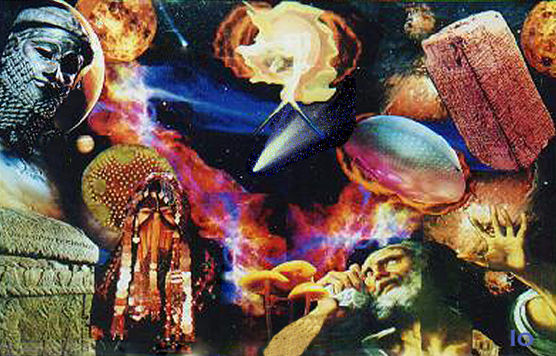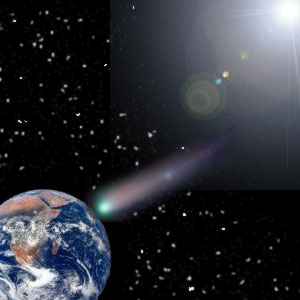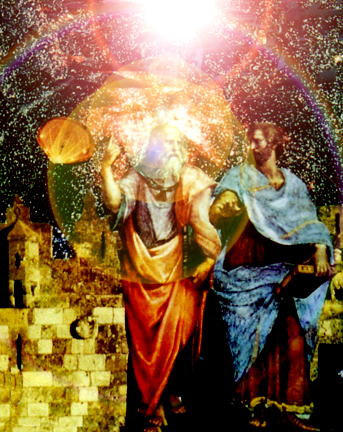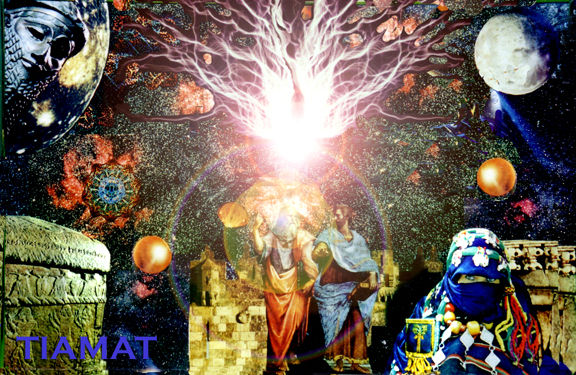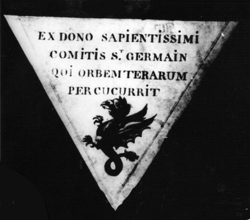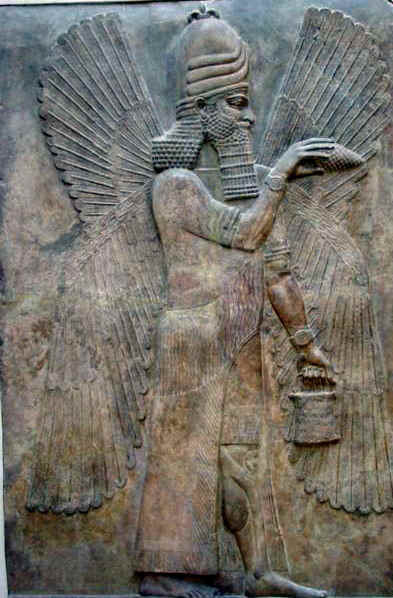The Flood
The Great Flood and the Dragon in Asia and Egypt;
Find things lost in the seas since the flooding of the globe.
Treaures Lost Since the Dawn of History: Creation, Destruction, Immortality
By 1940, Harvard Astronomer Fred L. Whipple had adduced comet Encke as a remnant of larger parent body which had been in a short period (around 3.3 years) low inclination (3.6 - 16 degree) orbit for between five and twenty thousand years; a long present spectacle for our ancestors as the comet progressively broke up creating the still active Taurid meteor streams(F.L. Whipple 1940). The very word DISASTER comes from the obsolete meaning of the malevolent force of a star or planet. Dis- (evil) aster (star). Thus, the fallen star or comet is the root of disasters, the mother of all disasters. Unlike meteorite falls which are detectable only instants before impact, comets can be viewed throughout their cyclic approaches to the Sun. The Earth passes through cometary debris, sweeping it up from its orbit. An occurrence inflicting widespread destruction and distress: calamity, cataclysm, catastrophe, tragedy.
CHAOS WAS AN UNIMAGINABLE FLOOD
Imagine you are an inhabitant of one of the first bustling but overcrowded cities on earth, a bountiful economy of agriculturalists and traders. Your priests bring the attention of all to a new star in the sky that seems to grow brighter and “hairier” in surprisingly short order. This evil eye in the sky is intuitively considered malevolent, upsetting the order of the heavens. It stirs something deep within racial memory which cannot quite be identified but is felt as primal awe and fear.
The comet wags its growing tail as it nears the sun and becomes ever more threatening as it nears earth, ever more foreboding as it increases in size and brightness, perhaps even rivaling sun and moon. Then one day that disturbing presence falls to earth and in an instant everything is profoundly changed – changed back to primeval chaos where survivors can’t tell sky from earth because terra firma has literally disappeared in an inundation of unbelievable scale immensely beyond their human memories of disasters.
GOD'S EYE & BREATH OF THE DIVINE SERPENT
But before the Flood actually arrives, a new sun seems to arise from the South Storm. Meteor showers of debris pepper the air even before the enormous fireball flares into instantaneous destruction. That fire is followed by the hot electrical breath of a sonic boom which trails electromagnetic chaos in the wake of the massive impactor.
Plasma auroras ripple, writhe and coil like serpents throughout the darkened sky. Megalightning rends the sky and jolts the ground and ignites fires that crackle and roar incessantly. The earth groans, shifts and buckles. The flood wind blows as the south-storm strikes the land – and strikes it hard, like a relentless Dragon with wave upon wave of assaults for six days and nights that never seem to end. It sounds like a mighty battle of titanic scope, of the Gods themselves.
This is no cross-cultural myth, but a real, if legendary event that exceeds the most fertile imagination. Ancient superstitions are the result, not the cause of the epics that came down to us as the beginning of history since all else was virtually destroyed. The priesthood consolidated its hold on the people, gazing at the heavens incessantly lest another such cosmic sojourner threaten their existence. The fact is, then, as now – real life disasters were an immanent threat, from earthquakes, volcanoes, tsunamis and climatic havoc.
The valley of Mesopotamia is dominated by two major rivers, the Tigris and the Euphraties, and numerous smaller ones. It was a land in which catastrophic floods were not unusual in ancient times, and it is unsurprising that stories about a major flood arose within the mythology of this area. Such stories might simply reflect an understandable preocupation with flooding in an area where flood disasters were an important reality. But this storm came from the South – from the Indian Ocean -- not upriver to the North.
ABYSSAL IMPACT
The sole survivors of the Sumerian, Akkadian, Babylonian and Biblical versions of the tale report the abject terror that rained down on humanity, virtually obliterating it from the world -- at least their world. The oldest timelines of the event are likely the most accurate. NOTE ~ this is a South Storm, not the flooding of the northern Black Sea of an earlier era:
'That stated time had arrived:
'He who orders unease at night, showers down a rain of blight.
'I watched the appearance of the weather.
The weather was awesome to behold.I boarded the ship and battened up the entrance.
With the first glow of dawn,
A black cloud rose up from the horizon.
Inside it Adad (the storm god) thunders,
While Shullat and Hanish (the heralds) go in front,
Moving as heralds over hill and plain.
Erragal (god of the underworld) tears out the posts (of the world dam);
Forth comes Ninurta and causes the dikes to follow.
The Anunnaki (gods of judgment) lift up the torches,
Setting the land ablaze with their glare.
Consternation over Adad reaches to the heavens,
Who turned to blackness all that had been light.
[That wide] land was shattered like [a pot]!
For one day the south-storm blew, [submerging the mountains],
Overtaking the [people] like a battle.
No one can see his fellow,
Nor can the people be recognized from heaven.
The gods were frightened by the deluge,
And, shrinking back, they ascended to the heaven of Anu (the father of
the other gods, who lived in the highest heaven).
The gods cowered like dogs
Crouched against the outer wall.
Ishtar (goddess of passion) cried out like a woman in travail,
The sweet-voiced mistress of the [gods] moans aloud:
'The olden days are alas turned to clay,
Six days and [six] nights
Blows the flood wind, as the south-storm sweeps the land.
When the seventh day arrived,
The flood(-carrying) south-storm subsided in the battle,
Which it had fought like an army.
The sea grew quiet, the tempest was still, the flood ceased.
I looked at the weather: stillness had set in,
And all of mankind had returned to clay.
The landscape was as level as a flat roof.
Seven days later, the waters began to subside:
I sat and wept,
Tears running down on my face.
I looked about for coast lines in the expanse of the sea:
In each of fourteen (regions)
There emerged a region(-mountain).
The dread exceeded all known disasters.
Instead of thy bringing on the deluge,
Would that a lion had risen up to diminish mankind!
Instead of thy bringing on the deluge,
Would that a wolf had risen up to diminish mankind!
Instead of thy bringing on the deluge,
Would that a famine had risen up to l[ay low] mankind!
Instead of thy bringing on the deluge,
Would that pestilence had risen up to smi[te down] mankind!

DRAGON DELUGE, DRAGON COMETS, DRAGON LINEAGE
1. To find things lost in the seas since the flooding of the globe.
The TRIANGLE BOOK begins by saying its wisdom comes by way of Egypt and Asia, then it urges us to look to the Flood. But how is the Dragon related to the Great Flood? How was life different before the Deluge? Both the Dragon and the Flood are clues that contextualize one another. Likewise Egypt and Asia.
A relief impression from the ritual Libation Cup of King Gudea of Lagash ( 2100 BC.) portrays the ancient Sumerian lion-serpent-dragon Tiamat. It stands guard over the terrestrial Tree Of Life, which is entwined with a serpent, one of the oldest known images of the snake and the caduceus.
GRAIL CUP OF SUMERIA
This cup certainly qualifies as a thing lost in the seas since the Great Flood, even though it was naturally buried on what is now dry land. The same is true for the plethora of cuneiform texts, including the Enuma Elish Creation Epic of Tiamat and The Epic of Gilgamesh that have been discovered in comparatively recent years.
Great treasures from the dawn of history have been found including fabulous artistic items ranging from golden lyres, to crowns, to sculptures of gold, though many were lost during the looting of museums in Gulf War II. These treasures are the collective inheritance of mankind, retrieving our prehistoric heritage, the immortality of mankind.
The original votive chalice is on exhibition in the Louvre Museum. It was a favourite possession of King Gudea, who ruled the Mesopotamian city of Lagash from 2141 to 2122 BC. However, the cup itself has been dated to as early as 4000 BC, which would explain the archaic Sumerian iconography and perhaps, the earliest known depiction of the Dragon in Indo-European history.
The cuneiform inscription reads:"To the god Ningizzida, his god Gudea, patesi of Lagash, for the prolongation of his life, has dedicated this." Again, this is an antecedent to the theme of prolongation of life in the St. Germain Triangle Book. It is said that Ningizzida is identified with the star goddess Ishtar, who is also identified with the celestial Dragon Tiamat and often pictured with a caduceus of serpents climbing the tree of life.
From The Votive Chalice Of King Gudea Of Lagash
Dragon from St. Germain's Triangle Book and Indian Gardua Bird, another icon of Comets from the Fertile Crescent.BOMBARDMENT
In an article in the NY Times on Nov 14, 2006, scientist Dallas Abbott has identified the site of a large asteroid impact crater (the Burckle Crater) off of the island of Madagascar that struck the earth around 2800 BC. This asteroid landed in the seabed, and sent a 600-900 foot high wall of water - a megatsunami - around the Indian Ocean, impacting land as far away as Australia, and crashing onto the coast of Africa, up the Red Sea and Persian Gulf, and quite possibly into the Mediterranean Sea as well.
This asteroidal impact would have sent a huge surge of water into the mouth of the Tigris and Euphrates Rivers, flooding the ancient land of Sumeria, the source of the Biblical flood legend. Indeed, Sir Leonard Wooley, the archaeologist who discovered the city of Ur, found 30 feet of flood-deposited sand that separated the most ancient levels of the city from newer habitation levels on top of the flood debris.
Abbott's findings of deep-sea meteor/asteroid strike craters (which she has developed the technology to discover) indicates that large-scale cosmic strikes hit the earth much more frequently than scientists have previously postulated - perhaps every 1 to 3 thousand years, instead of every hundred thousand or so. Large asteroid strikes also produce weather alterations, and many more global phenomena. Interestingly, the period 2800BC is when the first dynasty of Egypt started.
Massive Impactor
The answers to the relationship of Dragon and Deluge are hidden in the mists of time. In the Babylonian Creation myth, Enuma Elish, the dragon Tiamat is primeval chaos prior to the separation of heavens and earth. It is plausible that the Great Flood stories originated in a recently discovered comet strike in the Indian Ocean 4800 years ago. Shortly thereafter Sumerian civilization arose with its myth of Floods and great watery dragons. Dragon's pearls are a worldwide symbol of abyssal impactors, the death rain of cometary debris.
The 3-mile wide comet slammed into the ocean, radiating a fireball, shockwaves and mega-Tsunamis that scoured the landscape, scorched the air, and released sonic blasts, incredible electrical discharges and torrential rains of ejected ocean water and solid ejecta. It was an utter Deluge. The 600 foot high waves carried huge deposits of sediment to land. Half the population or more died.
The dragon's form arose from his particular power of control over the waters of the earth and gave rise to many of the attributes singled out by different peoples as the whole myth developed. They were believed to live at the bottom of the sea, where they guarded vast treasure hoards, very frequently of pearls. Rain clouds and thunder and lightning were believed to be the dragon's breath, hence the fire-breathing monster. The significance of the dragon was its control over the destiny of mankind. Is it surprising it became confounded with the creation story?
Eliade, "Cosmogonic Myth," 174. 97 says The Flood story may be a late addition to Gilgamesh, but the theme of the inaccessibility of immortality is not."...and the seven judges of hell ... raised their torches, lighting the land with their livid flame. A stupor of despair went up to heaven when the god of the storm turned daylight into darkness, when he smashed the land like a cup."
-- An account of the Deluge from the Epic of Gilgamesh, circa 2200 B.C.v
The Sumerian Creator is pictured as forming dry land from the primaeval water in much the same way as the early cultivator in the Euphrates Valley procured the rich fields for his crops. The existence of the earth is here not really presupposed. All the world was sea until the god created land out of the waters by the only practical method that was possible in Mesopotamia. Also, the rivers of Mesopotamia could be terrible. The Dragon motif drew its imagery from the mighty Tigris and Euphrates, as much from flood as storm. Markduk, as king identified with Sun-god, conquers the once featureless and chaotic primaeval water, the Dragon of flood and storm.
In the Hebrew versions of Creation, the Deluge narrative emphasizes connections between the Semitic Babylonians and themselves. The Sumerian versions are the originals, derived by the Jews from Semitic channels in Babylon. They increased the rain to forty days and add that "the fountains of the deep" and "the windows of heaven" opened, which sounds like the horrendous effects of a massive impact.
Some contributory cause other than local rain must sought for the magnitude of catastophes beyond those the rivers could cause. Mega-tsunami is orders of magnitude far far beyond local flood. Excavations at Ashur reveal a tablet describing a true dragon with legs, implying it crawls up onto land. A god announces the presence of the dragon, saying "In the sea he lies...." Then he describes its humongous size.
In the sea was the Serpent cre[ated].
Sixty /bêru/ is his length;
Thirty /bêru/ high is his he[ad].
For half (a /bêru/) each stretches the surface of his ey[es];
For twenty /bêru/ go [his feet].
He devours fish, the creatures [of the sea],
He devours birds, the creatures [of the heaven],
He devours wild asses, the creatures [of the field],
He devours men,[5] to the peoples [he . . .].
There are ample grounds, then, for assuming the independent existence of the Babylonian Dragon-myth, and though both the versions recovered have come to us in Semitic form, there is no doubt that the myth itself existed among the Sumerians. The dragon motif is constantly recurring in descriptions of Sumerian temple-decoration, and the twin dragons of Ningishzida on Gudea's libation-vase, carved in green steatite and inlaid with shell, are a notable product of Sumerian art. The very names borne by Tiamat's brood of monsters in the "Seven Tablets" are stamped in most cases with their Sumerian descent, and Kingu, whom she appointed as her champion in place of Apsû, is equally Sumerian. It would be strange indeed if the Sumerians had not evolved a Dragon myth, for the Dragon combat is the most obvious of nature myths and is found in most mythologies of Europe and the Near East. The trailing storm-clouds suggest his serpent form, his fiery tongue is seen in the forked lightning, and, though he may darken the world for a time, the Sun-god will always be victorious. In Egypt the myth of "the Overthrowing of Apep, the enemy of Ra" presents a close parallel to that of Tiamat.
Texts of Sethos II (1215-1210) tells that "Sekhmet was a circling star which spreaed out his fire in flames, a fire-flame in his storm." From Ugarit we hear, "The star Anat has fallen from the heavens; he slew the peopleof the Syrian land and confused the two twilights and the seats of the constellations." The Zoroastrians claimed it unleashed first terrible fire and then a flood called Tistrya. Widespread peoples described it burning and flooding. The old Sumerian tale is thus not the only lengend of comet-fall but is perhaps the oldest. Even passing through the debris trail of a comet can wreak destruction and rain hellfire. Halley's comet has an erratic course but appeared in 451AD and 1225 BCE.
The Greek myth of Phaeton described a fiery comet that ended the Golden Age, wreaking climatic havoc in the second half of the Thirteenth Century BCE.
Monday, May 25, 1998 Published at 12:41 GMT 13:41 UKSci/Tech
Clues to Bronze Age comet strike

Evidence is growing that a huge comet smashed into the Earth about 4,000 years ago.
Scientists are pointing to studies of tree-rings in Ireland which have revealed that about 2,354-2,345 BC there was an abrupt change to a colder climate.
They have also highlighted discoveries by archaeologists in northern Syria of a catastrophic environmental event at about the same time. This is also about the time that Bronze Age civilisations collapsed.
Firework displays of meteors
Dr Bill Napier, an astronomer at Armagh Observatory, and Dr Victor Clube, from Oxford and Armagh universities, say the evidence points to a comet hitting the Earth, and have called for more research.
Writing in Frontiers, the magazine of the Particle Physics and Astronomy Research Council, Dr Napier suggests that the Comet Encke, first observed in 1786, might be a remnant of the object along with its associated stream of meteors, called the Taurids.
This giant mother-comet is thought to have been disintegrating as recently as 5,000 years ago.
At this time, and for some millennia afterwards, the night sky would have been lit up by a bright light caused by dust particles, cometary fragments, and firework displays of meteor storms. The scientists highlight ancient civilisations' preoccupation with the sky. Cosmic icons were widespread .
Dr Napier wrote: "People have assumed that this was driven by the need for a calendar for both agricultural and ritual purposes. "However, this explanation does not account for the doom-laden nature of much cosmic iconography and early sky-centred cosmic religions associated with these societies."
Icons apparently depicting comets were widespread among early civilisations. The new evidence also ties in with ancient prophecies, including the Book of Revelations in the Bible, which appears to describe cataclysmic events involving objects falling from the sky. Dr Napier said the ancient swastika, a symbol of great antiquity stretching back to at least 1400 BC and found from China through India to the New World, may also be a cometary image.
Though gaining a detailed understanding of the effects episodic encounters with comets had on humanity will take some time, incorporating recent astronomical evidence can provide immediate boons to our comprehension of past cultures. This is particularly true for certain symbols and motifs that have endured to our time period. Wilson's 1894 work on the history of the swastika is quite valuable in showing how widely that symbol was utilized and what meanings came to be associated with it.
| |
| |
| The fortunate find in the seventies, at Mawangdui, China, of a Han dynasty silk comet atlas sheds considerable light on earlier enigmatic motifs. Most illuminating is the drawing, described by text on the artifact as a long-tailed pheasant star. This rendering of a jetting comet viewed down its axis of rotation has a considerable history, and, as a motif, appears on artifacts found in most areas of the world. The artist who illustrated this silk twenty-two hundred, or so, years ago was not likely a first-hand observer. What is produced here is a schematic of received comet caricatures with claims that specific things will happen if a represented type appears. The pinwheel-like image is unique to the compilation in that an omen is given for an appearance in each of the four seasons, implying that this comet was seen more often than the others represented. This may illustrate a frequently viewed aspect of comet Encke which has a 3.3 year orbit and rotational axis that occasionally points toward Earth. [Whipple, F. 1985] | |
| Important in understanding ancient oriental lore is learning that this motif was associated with the pheasant (divine bird in China) which is frequently mentioned in the Chinese classics. The link between the spinning cross and birds is evident on artifacts from many cultures. Perhaps the association of the Sanskrit term "svastika" with this symbol can be linked to the Astika Parva in the MAHABHARATA which relates the birth of a cosmic bird par excellence--Garuda. This fabulous winged deity had a radiance like the Sun, could change shapes at will, and destroyed other gods and kings by casting down fire and stirring up storms of reddish dust which darkened the Sun, Moon and stars. Clearly Garuda was symbolic of an Earth approaching comet. | |
The bird-comet connection is even more obvious in the Jamva-khanda Nirmana Parva of the MAHABHARATA which describes a fierce fowl with but one wing, one eye, and one leg, hovering in the night sky. As this bird "screams" and "vomits blood":
All the quarters of the earth, being overwhelmed by showers of dust, look inauspicious. Fierce clouds, portentous of danger, drop bloody showers during the night. Rahu of fierce deeds is also, O monarch, afflicting the constellation Kirtika. Rough winds, portending fierce danger, are constantly blowing.
The mention of Rahu, the demon of eclipse, which originally had four arms and a tail that was severed by Vishnu to become Ketu (comet) is interesting in that the demon is here darkening Kirttika (the Pleiades) in the month of Karttika (latter half of October, through mid November), for the tale goes on to relate that:
. . . in course of the same month both the Moon and the Sun have undergone eclipses on the thirteenth days from the day of the first lunation. The Sun and the Moon therefore, by undergoing eclipses on unusual days, will cause a great slaughter of the creatures of the earth. Meteors, effulgent like Indra's thunder-bolt, fall with loud hisses . . . People, for meeting together, coming out of their houses with lighted brands, have still to encounter a thick gloom all round . . . From the mountains of Kailasa and Mandara and Himavat thousands of explosions are heard and thousands of summits are tumbling down . . . Fierce winds charged with pointed pebbles are blowing, crushing mighty trees. In villages and towns trees, ordinary and sacred, are falling down, crushed by mighty winds and struck by lightning.
This is, without doubt, a mythological record of an intense meteor storm from the still active Taurid stream which presently peaks around the first of November and appears to radiate from near the Pleiades star cluster. The un-airworthy bird associated with this meteor bombardment could have been comet Encke which until recently was thought to be the sole source for the Taurid meteors. However, the discovery of other large contributors which are now dark but were once active comets rules out a positive identification. abob.libs.uga.edu/bobk/sw/swpi.html
Flood Candidates
THOTH
THE GREAT FLOOD & Crossroads Cultures
During the late Paleolithic, the retreat of the icecap in Europe caused climatic changes in North Africa, which became dryer over time. The Nile changed from a vast inland lake to a massive river, flanked by eight terraces. Worked stone age flints have been found from this era. Settlers found a valley of reedy swamps and shallows left by annual Nile floods, with abundant game. The first settlers were nomads who gradually settled to cultivate the land, whic easily produced abundant crops. Settlements unified and gradually came under coordinated control by Dynasty I in 3200 BCE.
Sumerian and Egyptian myths both relate how a god taught the art of writing and the knowledge of science to mankind. Thoth, the Egyptian God of Wisdom was most likely derived from even earlier Sumerian sources. Thoth was the god who supposedly sent a Flood to punish humankind for wickedness.
"...the Egyptians and the Sumerian people of Mesopotamia worshipped virtually identical lunar deities who were amongst the very oldest in their respective pantheons. Exactly like Thoth, the Sumerian moon-god Sin was charged with measuring the passage of time."
- Graham Hancock, The Sign and the Seal
"The name Sin is the Semitic form of Sumerian Enzu meaning lord of knowledge. The Mesopotamians ascribed very great importance to him. It was he who governed the passing of the months through his waxing and waning. ... The unvarying lunar cycle gave Sin a special connection with order and wisdom' and with immortality. The number seven is lunar in origin and is applied to the seven days of creation, the seven levels of hell and the seven great planets, Moon, Sun, Mercury, Venus, Mars, Jupiter and Saturn."
- Chris King, The Genesis of Eden
"The similarity between the two...gods is too close to be accidental...It would be wrong to say that the Egyptians borrowed from the Sumerians or the Sumerians from the Egyptians, but it may be submitted that the literati of both peoples borrowed their theological systems form some common but exceedingly ancient source."
- E. A. Wallis Budge, From Fetish to God
"The first races [of the doctrine of primordial egg where all life began] can be authenticated in the Pyramid Texts, where a union with the ibis Thoth takes place in the marshy area of the Delta:"
- Siegfried Morenz, Egyptian Religion
"Go, go to the two [halves of the] egg, go to Pe, to the Abode of Thoth."
- Pyramid Texts
"Thoth was called in the Pyramid Texts'He who reckons the heavens, the counter of the stars and the measurer of the Earth', the inventor of arts and sciences, scribe of the gods, the 'One who made calculations concerning the heavens, the stars and the Earth'. As the 'Reckoner of times and of seasons', he was depicted with a symbol combining the Sun's disk and the Moon's crescent upon his head, and - in words reminiscent of the biblical adoration of the Celestial Lord - the Egyptian inscriptions and legends said of Thoth that his knowledge and powers of calculating 'measured out the heavens and planned the Earth'. His hieroglyphic name Tehuti is usually explained as meaning 'He who balances'. Heinrich Brugsch (Religion und Mythologie) and E. A. Wallis Budge (The Gods of the Egyptians) interpreted that to mean that Thoth was the 'god of the equilibrium' and considered depictions of him as 'Master of the Balance' to indicate that he was associated with the equinoxes - the time when the day and the night were balanced."
- Zecharia Sitchin, When Time Began
Three accounts of an ancient store of wisdom hidden in pillars which may reflect a common tradition based on Thoth:
1.) A Hebrew tradition states that Enoch (the father of Methuselah) erected several columns before the flood and that a bronze one, which held a depository of the great philosophical and religious truths unknown to the world at large, survived.
2.) A third century AD Neoplatonic work, Corpus Hermeticum, tells how an Egyptian priest Manetho discovered the secrets of ancient rites that had been hidden in pillars, buried in a deep vault before the Deluge. (The Greeks equated their god Hermes with Thoth.)
3.) The "old ritual" of Freemasonry relates that the two great pillars placed in front of the Temple of Solomon had been hollow. Inside them had been stored the "ancient records" and the "valuable writings" pertaining to the past of the Jewish people.
The Archaic or Early Dynastic Period of Egypt is taken to include the First and Second Dynasties, lasting from 2920 BCE, following the Protodynastic Period of Egypt, until 2575 BCE, or the beginning of the Old Kingdom. Some Egyptologists also include the Third Dynasty.
According to Manetho, the first king was Menes. However, the earliest recorded king of the First Dynasty was Hor-Aha, and the first king to claim to have united the two lands was Narmer (the final king of the Protodynastic Period). His name is known because it is written on a votive palette[1] used for grinding minerals for kohl, used by ancient Egyptians to outline the eyes. Funeral practices for the peasants would have been the same as in predynastic times, but the rich demanded something more. Thus, the Egyptians began construction of the mastabas.
Prior to the unification of Upper and Lower Egypt circa 3100 BCE, the land was settled with autonomous villages. With the first dynasties, the rulers established a national administration and appointed royal governors. The buildings of the central government were typically open-air temples constructed of wood or sandstone.
The Archaic or Early Dynastic Period of Egypt is taken to include the First and Second Dynasties, lasting from 2920 BCE, following the Protodynastic Period of Egypt, until 2575 BCE, or the beginning of the Old Kingdom. Some Egyptologists also include the Third Dynasty.
According to Manetho, the first king was Menes. However, the earliest recorded king of the First Dynasty was Hor-Aha, and the first king to claim to have united the two lands was Narmer (the final king of the Protodynastic Period). His name is known because it is written on a votive palette[1] used for grinding minerals for kohl, used by ancient Egyptians to outline the eyes. Funeral practices for the peasants would have been the same as in predynastic times, but the rich demanded something more. Thus, the Egyptians began construction of the mastabas.
Prior to the unification of Upper and Lower Egypt circa 3100 BCE, the land was settled with autonomous villages. With the first dynasties, the rulers established a national administration and appointed royal governors. The buildings of the central government were typically open-air temples constructed of wood or sandstone.
The Archaic or Early Dynastic Period of Egypt is taken to include the First and Second Dynasties, lasting from 2920 BCE, following the Protodynastic Period of Egypt, until 2575 BCE, or the beginning of the Old Kingdom. Some Egyptologists also include the Third Dynasty.
According to Manetho, the first king was Menes. However, the earliest recorded king of the First Dynasty was Hor-Aha, and the first king to claim to have united the two lands was Narmer (the final king of the Protodynastic Period). His name is known because it is written on a votive palette[1] used for grinding minerals for kohl, used by ancient Egyptians to outline the eyes. Funeral practices for the peasants would have been the same as in predynastic times, but the rich demanded something more. Thus, the Egyptians began construction of the mastabas.
Prior to the unification of Upper and Lower Egypt circa 3100 BCE, the land was settled with autonomous villages. With the first dynasties, the rulers established a national administration and appointed royal governors. The buildings of the central government were typically open-air temples constructed of wood or sandstone.

